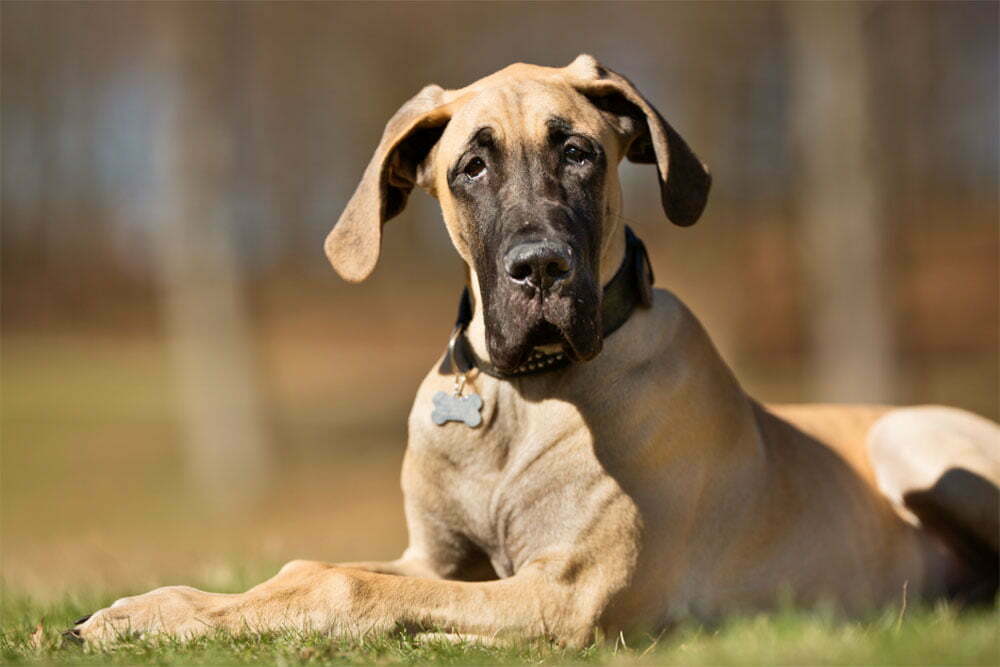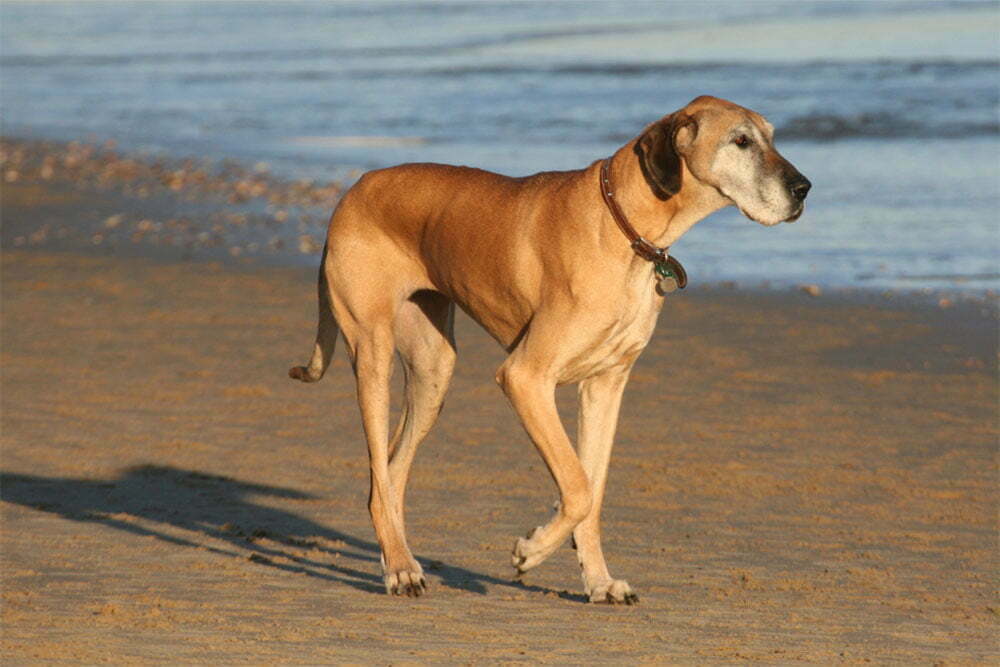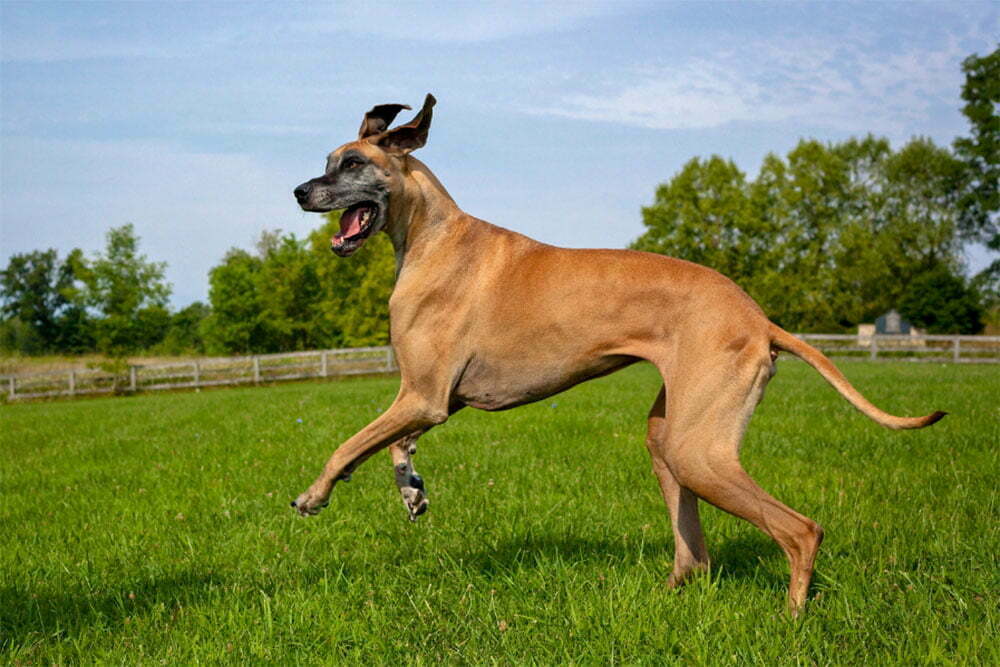Known to grow to the size of a small horse, don’t be fooled into letting this breed’s impressive size put you off. Nicknamed the ‘gentle giants’ of the dog world, the Great Dane is a big dog with an even bigger heart.
For all of its size, the Great Dane is a loving, loyal, affectionate pet and would make a great addition to any family.

See below for everything you need to know about these gentle goliaths – from breed characteristics to fun facts!
Key facts
Considering getting a Great Dane? Or you just want to know the basics? Below are some of the most important facts to consider when it comes to these loveable giants.
Average lifespan
The average lifespan of a Great Dane is relatively short in relation to smaller breeds and can vary between 7-10 years. However this should not look to put any potential Great Dane owners off as a shorter time together does not make the time spent with one of these giant dogs any less worthwhile.
Minimum exercise (per day)
Being such a large breed, you’d be surprised to know that Great Danes only require around 30 minutes to an hour of exercise around twice a day!
And this doesn’t just have to be in the form of walks, play is a great way to help exercise your dog whilst also strengthening your bond and can reduce stress in both you and your furry companion.
It is strongly recommended however, that you do not take your Great Dane puppy out running or allow them to undergo heavy exercise until they are at least 18 months old as their bones are still growing and you can cause damage if they are exercised too much whilst still developing.
Coat length
Great Danes have a smooth, short coat which comes in six different color variations:
- Black
- Blue (steel blue – which is really more of a gray)
- Brindle (fawn and black tiger stripe pattern)
- Fawn (golden all over with a black mask)
- Harlequin (white with irregular black patches all over)
- Mantle (black and white with a solid black blanket over the body)
Minimum cost (per month)
It may surprise you to learn that Great Danes don’t require a huge amount of food to keep them in great shape and condition.
That said however, this is still going to be your biggest recurring expense.
Good quality dog food is very important when choosing what to feed your Great Dane.
By choosing a good quality dog food it will help provide your pet with the best possible nutrition and can help to avoid potential health issues from arising in the future such as joint problems as vet bills can be very costly!
On top of food, your dog will require monthly flea and worming treatment and you may also be looking at sending your Great Dane to doggy daycare for a few days a week as well.
The important part:
- Good quality dog food can set you back anywhere between $80 to $200 dollars a month
- Flea and worming medication, will have a monthly cost of around $10 to $30
- And doggy daycare on average can cost you about $40 per day
So overall you could be looking at up to $400 a month to care for your Great Dane.
Appearance
Instantly recognisable, the Great Dane is a show stopper.
The perfect blend of sleek yet muscular, elegant but powerful, when walking one of these regal looking dogs you will be sure to be attracting glances from every angle.

Their long graceful neck extends into a large, long, narrow head with deep set eyes and an often thoughtful expression that many fall in love with.
Size
Great Danes are most well known for their impressive size and stature. Coming in at over 101lbs they are classified as an extra large or giant breed.
Though the Great Dane is loved for its size, there are some problems that can come from this.
Even the biggest dog lovers could become nervous when faced with a dog who weighs as much as them and though we know these gentle giants wouldn’t hurt a fly, don’t be surprised if you see people crossing the street to avoid you when out on your walks.
The Great Dane’s tail can be quite the hazard, especially in a small space so you need to make sure you keep those coffee tables clear of any glassware or valuables or they might end up in pieces on the floor!
Average height
The average height of a male Great Dane can vary between around 30-34 inches tall, whereas a female Great Dane usually stands at about 28-32 inches.
Average weight
On average a male Great Dane weighs in at around 120-200lbs and a female can reach anywhere between 100-130lbs.
Temperament
Gentle, loving, friendly – these are all words that have cropped up multiple times throughout this guide and that’s because the Great Dane embodies these qualities.
As good natured as they are it is still very important that you socialize your Great Dane puppy from an early age to make sure they grow up to be a happy, well rounded dog.
Apartment living
A Great Dane would not make a great apartment dog purely due to how big they are.
They require a lot of space to move around, and a big garden would be ideal for this breed. Luckily the Great Dane is not a jumper so a six foot fence should be enough to easily contain them.
Good for novice owners
As wonderful as this breed is, they probably aren’t the best choice for a novice dog owner.
It’s not that Great Danes are difficult to train or but rather this is because they require a lot of work.
Their size means that any potential owner will have to put a lot of time into training them and if you’ve never owned a dog before this may be a bigger undertaking than first expected.
They are also just an expensive dog to own and care for and the costs can very easily add up, so they’re definitely not a breed to purchase just because you like the way they look.
But if you’re serious about this breed and understand all of the downsides, are properly prepared, patient and determined there’s no reason why (even if you’ve never had a dog before) you couldn’t become a fantastic Great Dane owner.
Sensitivity level
Despite their imposing appearance Great Danes are sensitive souls. Gentle and loving, these dogs are really just big babies and do much better with positive reinforcement rather than negative.
Tolerates being alone
All dogs are pack animals and the Great Dane is no different. A sociable and people originated breed, these dogs crave human company and have no issues pushing their big heads into you when they haven’t had any attention in a while.
Under no circumstances are Great Danes outdoor dogs and need to be close to their families or they may begin to display signs of anxiety.
Tolerates cold weather
Great Danes do not do well in cold weather due to their short smooth coat and it is often recommended that you get them a coat or jumper for the winter seasons.
Tolerates hot weather
Compared to the cold the Great Dane copes well and even enjoys the warmer weather, often enjoying some sunbathing. Always ensure fresh water is available for your dog in hot weather to avoid dehydration.
Affectionate with family
Without a doubt the Great Dane is a family dog.
They bond very strongly to their family members and love to be around them.
Often forgetting their own size, many Great Danes believe they’re lap dogs and will see nothing wrong with climbing up onto the sofa to snuggle with you.
Kid-friendly
Great Danes are very patient and gentle with children especially when they have been raised amongst them. Their laid back personality allows them to withstand most of the stresses that young children can put them through.
It is worth keeping in mind though, that Great Danes are not aware of their size and could accidentally knock a small child over so, as with any dog, all interactions must be supervised.
Dog friendly
In general Great Danes are happy go lucky, loving and sensitive dogs that get on with people and animals alike.
They are gentle playmates but due to their size and strength this may prove too much for smaller dogs even though Great Danes usually always mean well when interacting with others.
Friendly towards strangers
Though Great Danes have an image for being ‘gentle giants’ they were originally bred to be guard dogs.
With this instinct and the immense amount of love they feel for their family Great Danes may become wary around strangers, therefore it is important to socialize your Great Dane from a young age to ensure they are comfortable around new people.
Health and Grooming
Shedding
Great Danes are seasonal shedders meaning the amount they shed is usually worse when entering the spring time as the temperatures begin to warm up and they begin to lose their winter coat.
Being a giant breed, there is a lot of extra fluff to contend with but don’t worry as this 5yis easily kept on top of with regular brushing.
Drooling
Adorable floppy jowls often come hand in hand with the tendency to drool and this is one area that Great Dane owners will not be able to combat.
The science behind why Great Danes drool a lot is simply due to their facial composition. Having a square jaw and loose lips means that drool can easily pool in their folds which leads to it running out of their mouth and often onto your leg!
Unfortunately Great Dane slobber is one of things that can’t be helped so it is recommended you have a drool rag to hand to help clean up any messes.
Though drool is one of the less attractive traits a breed can have, for those who love their dogs a bit of slobber won’t pose much of an issue.
Grooming
One of the less high maintenance breeds, Great Danes do not need to visit the groomers to keep their coats in fantastic condition and can be easily managed at home.
Regular weekly brushing should help keep your Great Danes coat in tip top condition year round, with additional brushing when it comes to shedding season.
Getting your Great Dane used to being brushed and handled as a puppy will help to make this process a whole lot smoother!
It is also important to make sure that you trim your Great Danes nails once or twice a month if they are not worn down naturally.
General health
Great Danes are generally a healthy breed but like all dogs they are prone to certain health conditions.
Now it’s not to say that every Great Dane will experience any of these conditions but it is important for potential owners to be aware of them all the same.
Common health problems
- Heart disease
- Eye conditions
- Hip dysplasia
- Gastric Torsion (aka bloat)
- Arthritis and joint pain
- Cancer
Potential for weight gain
This breed is not one that struggles with obesity, just make sure you feed your Great Dane the recommended amount of food and there should be no trouble.
Trainability
Easy to train
Great Danes tend to be people pleasers through and through, which usually makes them very easy to train.

But much like people, dogs have unique personalities and some Great Danes are known to have a strong will and aren’t afraid to make you prove you can control them.
Therefore consistent and positive reinforcement works excellently for this breed.
Intelligence
There are many things going for the Great Dane but intelligence is not at the top of that list.
Considered of average intelligence, they aren’t the smartest cookie in the box but they are clever enough to learn commands and their place in the pack, making them happy healthy members of your family.
Potential to bite
As with every breed, there is always a potential for a Great Dane to become aggressive.
This becomes a serious issue when considering the size and power of a Great Dane – if you were bitten by a Great Dane you would certainly know about it.
Luckily however Great Danes have a reputation for being good natured and friendly (you’re more likely to be slobbered on than bitten) and therefore are not considered a biting risk or dangerous dog.
Tendency to bark or howl
Bred to be hunters and guard dogs, Great Danes can still hold on to these tendencies and won’t ever fail in letting you know when there’s someone at the front door.
Despite this however they are usually placid and quiet dogs and will only bark to let you know something is up.
History
Despite the name, the Great Dane has German origins and not Danish!
Originally bred to be boar hounds, these dogs were known to be ferocious hunters and serious guard dogs but the breed soon became popular amongst German noblemen and they began to breed them as pets, making sure to focus on changing the temperament from that of fearsome beast to loveable oaf.
The Great Dane was first recognized by the AKC (American Kennel Club) in 1887 and to this day remains one of the 20 most popular dog breeds in the U.S.
Costs
A Great Dane puppy is likely going to set you back anywhere between $1000 to $3000.
And the bigger the dog, the more expensive everything becomes. As they are an extra large breed they will require extra large collars, beds, crates, food bowls – all of which increase in price the larger you go.
Potential vet bills for an average healthy Great Dane, with no special treatment have been estimated to be anywhere between $500-$3000 for their lifetime so this is definitely a cost that should be taken into account when considering one of these dogs.
It can’t be ignored that Great Danes can be very expensive but if you’re looking for a large, placid and loveable companion and are prepared to meet these costs then a Great Dane might just be the perfect dog for you.
Fun facts
- Beloved cartoon sidekick, Scooby Doo is a Great Dane but unlike the real dogs, Scooby is a lot less laid back and placid!
- A Great Dane called Zeus is the current Guinness World record holder for being the tallest dog, standing at an impressive 1.118m (44 inches) tall! It was reported that Zeus would eat approximately 30lb of dog food every two weeks, but he unfortunately passed away when he was only 5 years old.
